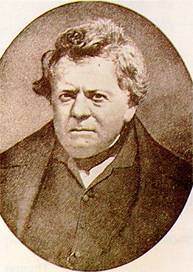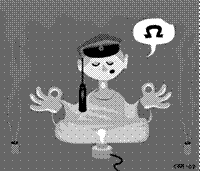Handout #13: Georg Simon Ohm

 German physicist
German physicist
Born: Erlangen, Bavaria, March 16, 1787
Died: Munich, Bavaria, July 7, 1854
Ohm was the son of a master mechanic who was interested in science and who went to some pains to see that the youngster received a scientific education. Science was not, however, to deal kindly with Ohm.
He taught in high schools, but his ambition was to achieve a university appointment. To do this he had to produce some important research work and he tackled the new field of current electricity that had been opened by Volta. But he was poor and equipment was hard to get, so he made his own. In particular he drew his own wires, and the influence of his mechanic father stood him in good stead.

Ohm decided to apply to the flow of electricity some of the discoveries made by Fourier concerning the flow of heat. Just as the rate at which heat flowed from point A to point B depended in part upon the temperature difference between those two points and in part on the ease with which heat was conducted by the material between, so the rate of flow of electric current should depend upon the difference in electrical potential between points A and B and upon the electrical conductivity of the material between.
By working with wires of different thicknesses and lengths he found the quantity of current transmitted was inversely proportional to the length and directly proportional to the cross-sectional area of the wire. He was in this way able to define the resistance of the wire and in 1827 to show that there was a simple relation between that resistance, the electric potential, and the amount of current carried. This came to be called Ohm's law and can be expressed: "The flow of current through a conductor is directly proportional to the potential difference and inversely proportional to the resistance." (Nearly half a century earlier Cavendish had discovered this relationship, but he had never published.)
This was Ohm's only first-class contribution to science, but one first-class contribution is quite enough, and he deserved his university appointment. He did not get it, however. His work stirred up a good deal of opposition and resentment, apparently because Ohm tried to base his results on theory and some of his audience did not understand that good, thorough experimental work was also involved. In any case Ohm met with so much criticism that he was forced to resign even his high-school position.
 For six years he lived in poverty and bitter disappointment, while very slowly his work became known and appreciated outside Germany. He found himself, probably to his own surprise, coming to be held in honor. The Royal Society gave him its Copley medal in 1841 and made him a member in 1842. Finally, prophet Ohm came to be honored even in his own country and he was appointed to a professorship at the University of Munich in 1849 so that the last five years of his life were spent in the sun of ambition realized at last.
For six years he lived in poverty and bitter disappointment, while very slowly his work became known and appreciated outside Germany. He found himself, probably to his own surprise, coming to be held in honor. The Royal Society gave him its Copley medal in 1841 and made him a member in 1842. Finally, prophet Ohm came to be honored even in his own country and he was appointed to a professorship at the University of Munich in 1849 so that the last five years of his life were spent in the sun of ambition realized at last.
His name is further immortalized in the fact that the unit of resistance is the ohm. Thus, when a current of one ampere passes through a substance under a potential difference of one volt, that substance has a resistance of one ohm. Furthermore, the unit of conductance (which is the reciprocal of resistance) is the mho—Ohm's name spelled backward.
Home